Squad Operations
JOEs Are Important Too!
References: TC 3-21.76 (Ranger Handbook) | ATP 3-21.8
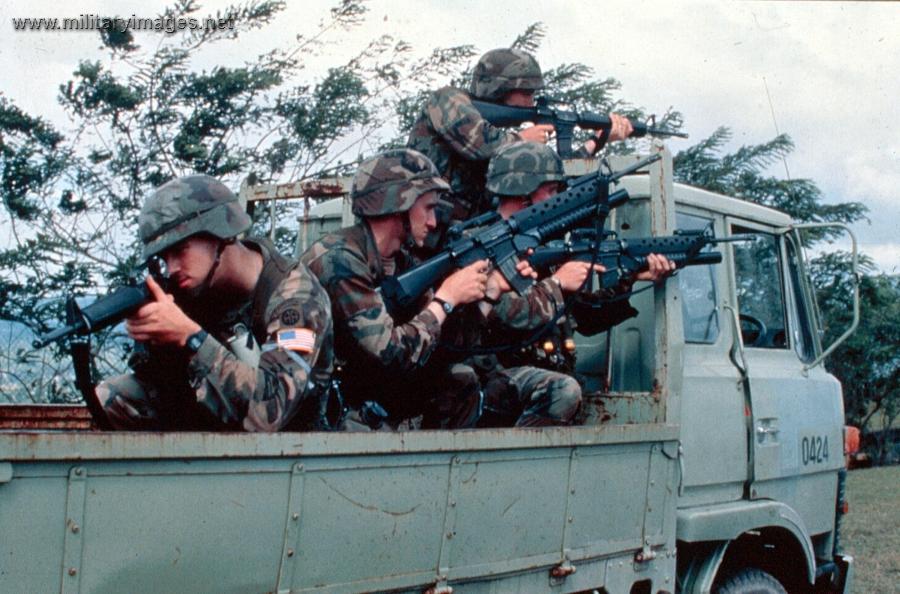
Overview
The Army operates as a team to accomplish its objectives and defeat its enemies. The squad is the second smallest organizational unit in the Army, capable of operating independently or as part of a larger structure, such as a platoon, for more complex missions.
Understanding your role in the squad is critical for mission success. This article covers squad structure, movement formations, and individual drills.

Roles
Before diving into structure, let’s review the key roles in an infantry rifle squad.
Squad Leader (SL)
As the senior leader, the Squad Leader is responsible for everything the squad accomplishes or fails to accomplish.
The SL operates independently without constant guidance from higher command, maintaining troop discipline and motivation. There are typically four squad leaders in a platoon.
Responsibilities:
- Subject matter expert on drills and weapons.
- Uses control measures for fires.
- Controls squad movement.
- Sends situation reports (SITREPs) to higher command.
- Understands the mission and commander’s intent.
- Prepared to assume the role of Platoon Sergeant (PSG).
Added Note: The SL must communicate effectively with the platoon leader and ensure the squad’s actions align with the broader mission. They also conduct pre-combat checks to verify equipment and readiness.
Team Leader (TL)
The TL is the senior leader of a fire team, leading by example. Their role is similar to the SL but on a smaller scale. There are typically two team leaders in a squad.
Responsibilities:
- Subject matter expert on drills and weapons.
- Leads the team effectively.
- Employs security measures.
- Assists the SL as needed.
- Prepared to assume SL or PSG roles.
- Enforces discipline.
- Leads maneuvers.
- Understands squad and platoon missions.
Added Note: The TL ensures fire team members are positioned correctly in formations and coordinates with the SL during engagements to maintain tactical cohesion.
Automatic Rifleman (AR)
The AR operates the M249 Squad Automatic Weapon (SAW), the primary casualty-producing weapon in the fire team. There are typically two ARs in a squad.
Responsibilities:
- Subject matter expert on the M249 SAW.
- Provides suppressive fire.
- Accomplishes tasks of Rifleman (RFLMN) and Grenadier (GRN).
- Engages groups of exposed personnel.
- Prepared to assume TL or SL roles.
Added Note: The AR’s suppressive fire is critical for enabling maneuver by pinning down the enemy. They must maintain ammunition discipline to sustain fire during engagements.
Grenadier (GRN)
The GRN operates the M203 or M320 grenade launcher weapon systems. There are typically two GRNs in a squad.
Responsibilities:
- Subject matter expert on the grenade launcher.
- Accomplishes tasks of a Rifleman.
- Engages targets with precision.
- Prepared to assume TL role.
Added Note: The GRN uses high-explosive or smoke rounds to engage point targets or obscure enemy positions. They must coordinate with the AR to maximize fire team effectiveness.
Rifleman (RFLMN)
The Rifleman carries the M4A1 assault rifle to deliver well-aimed fire on the enemy. There are typically two Riflemen per squad.
Responsibilities:
- Subject matter expert on the M4A1.
- Fights as part of a unit.
- Engages targets accurately.
- Prepared to assume TL role.
Added Note: The Rifleman often serves as a point man or scout during movement, requiring strong situational awareness and map-reading skills.
Structure
The Army is highly structured, from the smallest unit—a fire team of 2–4 soldiers—to an Army with over 50,000 soldiers. This section focuses on team and squad-sized elements.
Fire Team
The fire team is the smallest fighting element within the platoon, typically composed of four soldiers: a Team Leader (TL), Automatic Rifleman (AR), Grenadier (GRN), and Rifleman (RFLMN). A squad contains two fire teams, and a platoon has eight fire teams.
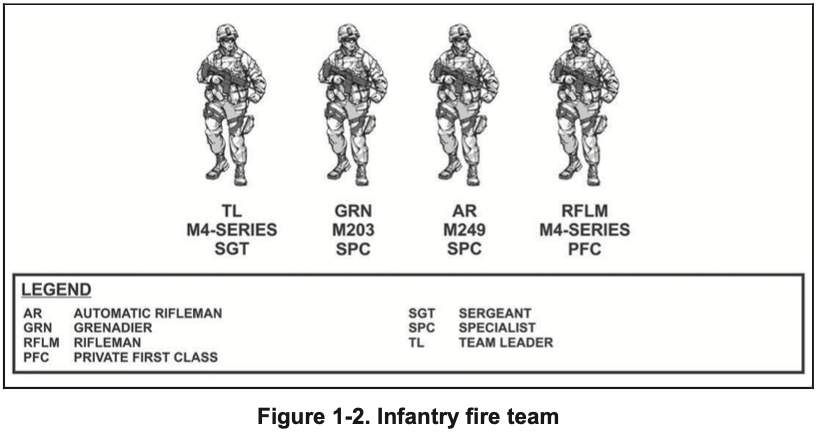
Squad
The squad’s primary role is to maneuver or serve as a base-of-fire element, forming the model for all tactical task organizations. It consists of two fire teams and a Squad Leader. The Team Leaders act as subordinates to the Squad Leader.
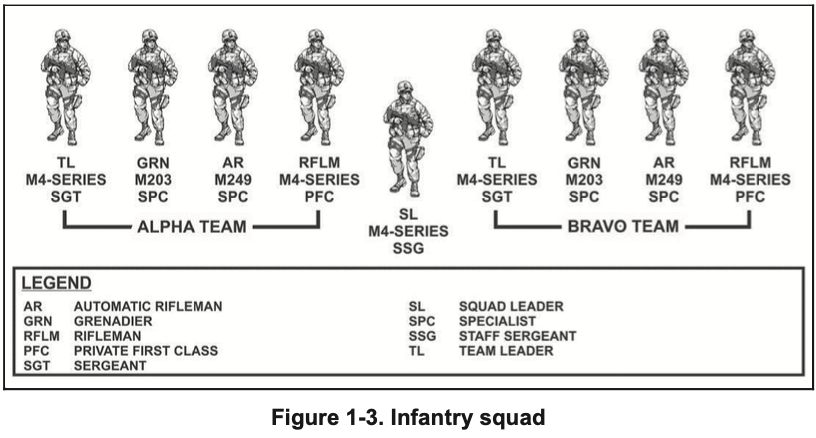
Added Note: Squads can be task-organized with additional assets, such as medics or forward observers, depending on the mission.
Movement Formations
Formations are ordered arrangements of forces, adjusted based on the enemy and situation. They ensure soldiers know their positions relative to others for effective command and control.
Fire Team Formations
These refer to the soldiers’ relative positions within the fire team.
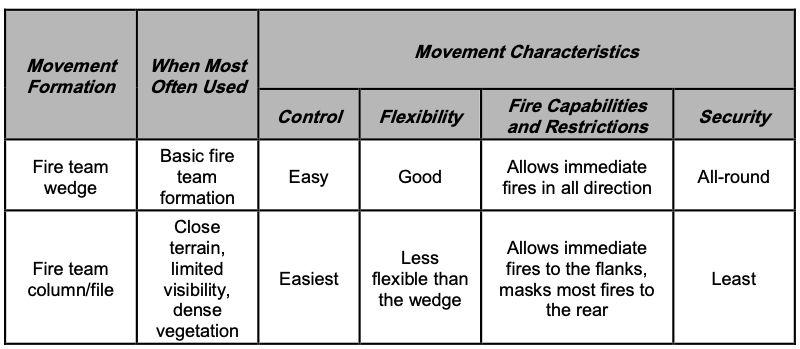
Fire Team Wedge: The basic fire team formation, used whenever possible. It provides good all-around security and flexibility.
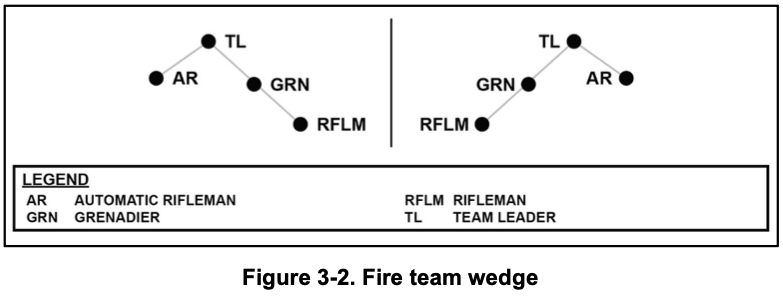
Fire Team Column: Used when the wedge is impractical, such as in dense terrain. Avoid when possible, as it offers less security than the wedge.
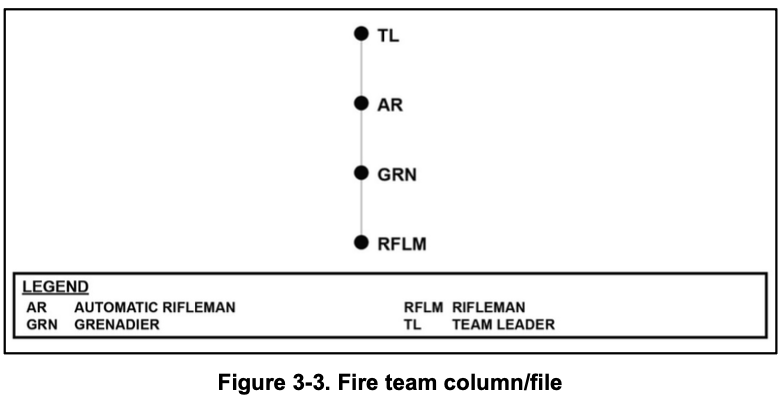
Added Note: In the wedge, the TL leads, with the AR, GRN, and RFLMN positioned to maximize firepower and observation. In the column, soldiers follow in a line, reducing their ability to engage threats from multiple directions.
Squad Formations
Squad formations are ordered arrangements of the two fire teams and the Squad Leader, adapted to the situation.
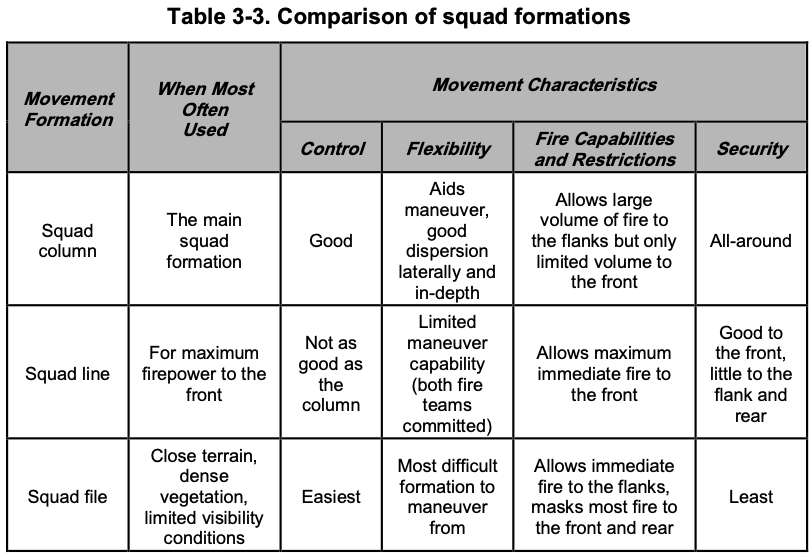
Squad Wedge: Combines two fire team wedges, with the SL in the center for command and control.
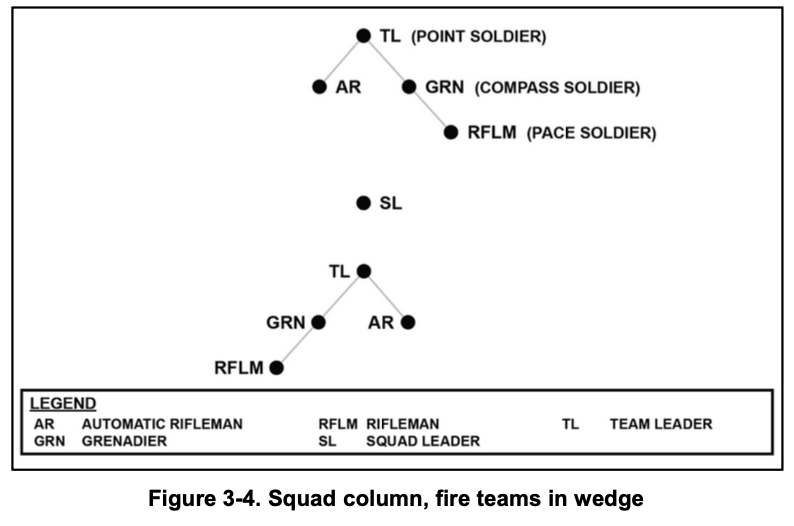
Squad File: Similar to the fire team column, with the SL in the center to issue orders. Used in narrow or restrictive terrain.

Added Note: The squad wedge maximizes firepower to the front and flanks, while the file is better for rapid movement through confined areas but is vulnerable to ambushes.
Movement Techniques
Movement techniques refer to the distances between soldiers and squads, varying by situation, terrain, and enemy threat.
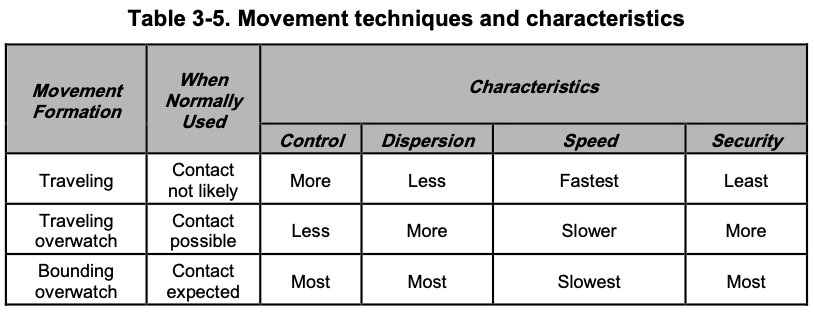
Bounding
Bounding is an effective method for advancing toward the enemy while maintaining security. One element provides cover (base of fire) while the other moves, then they alternate.

Alternate Bounding: A leapfrog effect where fire teams move past each other. Faster but less secure, as the overwatching element may lose sight of the moving element.
Successive Bounding: Fire teams stay in line, moving one at a time while the other provides cover. Slower but safer, maintaining continuous observation.
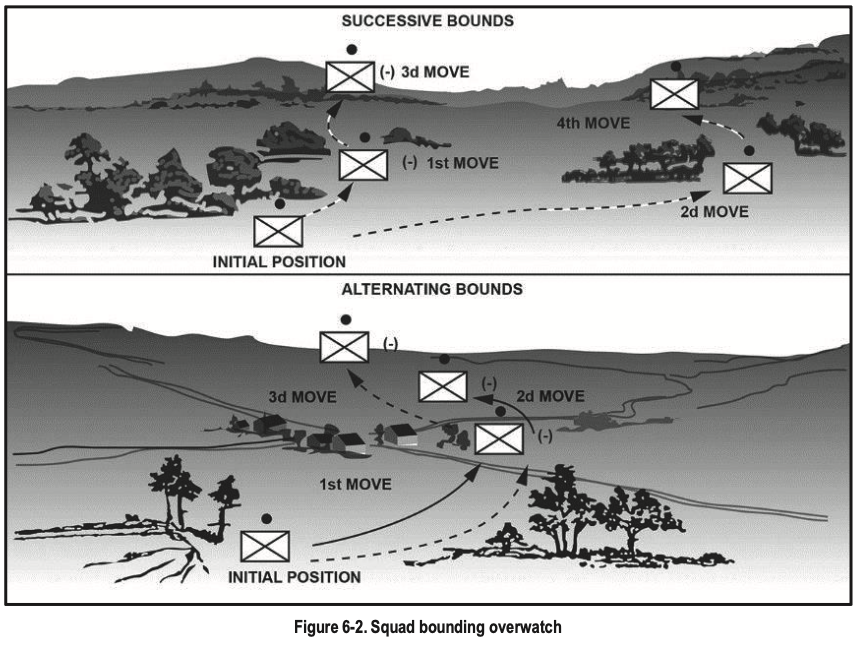
Added Note: Bounding requires clear communication (e.g., hand signals or radio) to coordinate movement and avoid friendly fire. The SL designates which team moves first and sets the pace based on the threat.
Individual Movement Techniques (IMT)
IMTs are used when under fire to minimize exposure and maintain maneuverability.
- High Crawl: Move on hands and knees, keeping the weapon ready. Used when cover is available but speed is needed.
- Low Crawl: Move on your belly, staying as low as possible. Used under heavy fire or minimal cover.
- 3–5 Second Rush: Move quickly between cover points, exposing yourself for no more than 3–5 seconds.
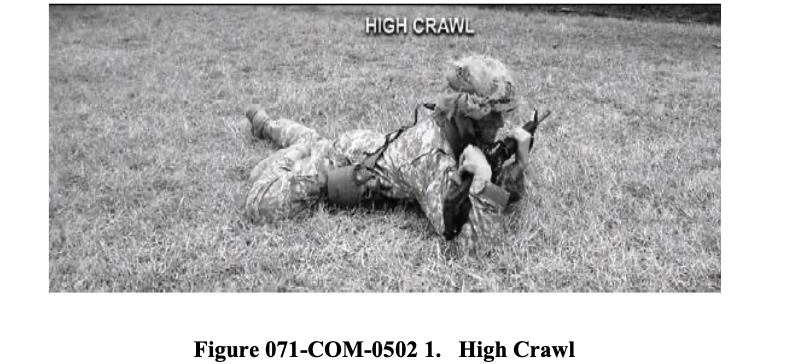
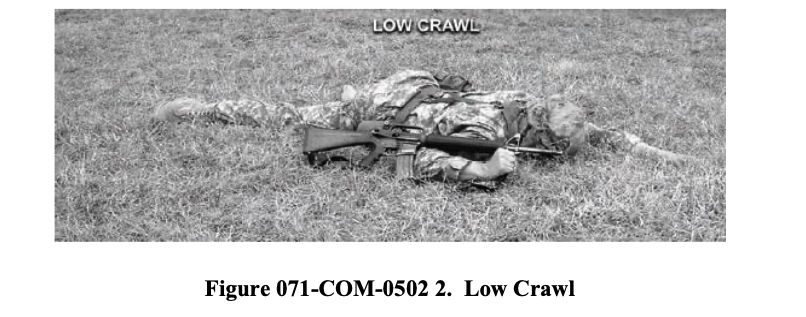

Added Note: Practice IMTs to build muscle memory. Always scan for cover before moving and communicate your intent to your team to avoid confusion.
Patrol Base (PB) and Objective Rally Point (ORP)
During a security halt, the squad spreads out to post security. The formation differs depending on whether it’s a Patrol Base (PB) or Objective Rally Point (ORP).
- Patrol Base (PB): A temporary defensive position for rest, planning, or resupply. Soldiers are positioned in a circular or triangular formation for 360-degree security.
- Objective Rally Point (ORP): A concealed position near the objective for final preparations or regrouping. Typically more compact than a PB.
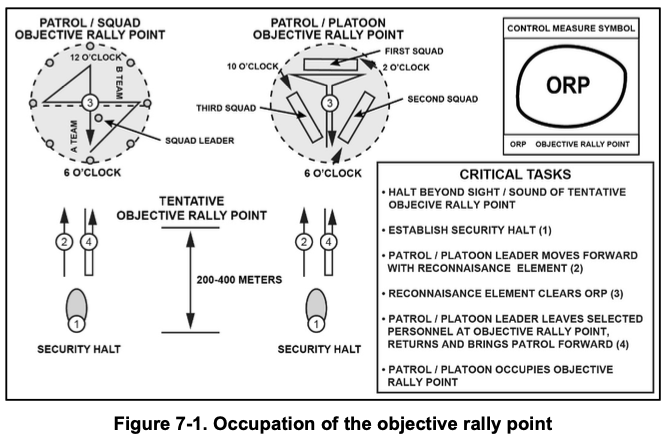
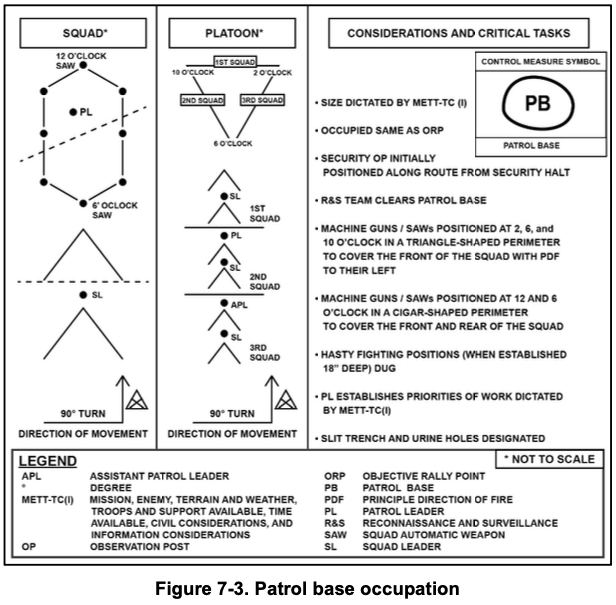
Added Note: In a PB, the SL assigns sectors of fire to each soldier to ensure overlapping coverage. In an ORP, minimize movement and noise to avoid detection. Both require clear communication of entry and exit procedures.
Slides
Here are the slides for reference, taken from the Intro to Squad Ops lab: